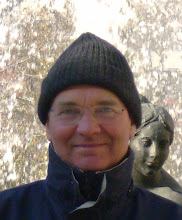
As you can see they're really quite small and discreet, 70mm in diameter and proud of the path surface by about 7 mm. So do they work? I checked a little after 10 pm last night when I took these pics so can confidently answer "no". The very most these studs will ever do is emphasise where the edges of the path are, mainly for the benefit of those using the path without lights on very dark nights. Anyone with half-decent lights would benefit far more from reflective material. The amount of light given off by the studs is absolutely minuscule and bears no resemblance to the pictures on the website.

Above is the close-up view at 10.22 pm last night, still twilight at this time of year but dark enough for lights to be necessary. The glow from the greenish plastic is barely visible and of absolutely no practical use. What the TraxEyes certainly will not do is help path users to see other path users which is what really matters. They may even give path users a false sense of security and result in more cyclists using the unlit path without adequate lighting, or cycling faster than they otherwise would because it's easier to see the alignment of the path.

The other question one might ask is "are they slippery?". The answer is yes, they are slippery if you attempt to brake or turn sharply while riding over them, especially in the wet. The example pictured above is particularly dangerous, being on a steeply sloping junction where cyclists are likely to be simultaneously turning and braking sharply (when they are suddenly confronted by a path user who they hadn't seen around the blind corner). If the tyre makes contact only with the plastic disc traction is greatly reduced and if combined with braking or turning, let alone both, the result is that you may well find yourself flat on the ground.
Now all of this has been flagged up before and, I understand, communicated to officers. So why have they gone ahead with the installation of these studs on a public path, presumably without first having carried out such simple tests as I did? If this path was a road open to motor traffic there would surely be no question of using these studs without Department of Transport authorisation following exhaustive safety tests. But it's just a path for cyclists and walkers so we get to be experimented on like laboratory rats.




6 comments:
There's a whole history in St Werburghs of fighting against unnecessary, wasteful street lighting on footpaths - you are on a more slippery slope than you realise...
You may, in the end, turn out to be right about this, who knows, but your testing of this product is hardly comprehensive and fully scientific Chris - lets wait until we have some proper data over a period of time shall we? No doubt the individual observations of path users should be an important consideration - but not just one persons opinion, observations, and a few photos (I personnally have doubts about the time you took the photos).
This technology may turn out to be unsuitable here but I think you are a bit premature and over-strong in your reaction.
I like the idea of more subtle, sustainable illuminations which guide people along the path, as opposed the oppressive glow and unaesthetic visual amenity of bulk-standard street lamps. One of the things I questioned (and often felt guilty about) when riding the Railway Path alone or at quiet times is the dreadful cost of street lamps to the council tax payer.
Personally, I think we should congratulate the Council for taking the initiative to conduct this trial. After all, many people (yourself included Chris) seem to bark on about things not being sustainable or green enough. I see this as a possible opportunity for real change.
Having ridden the bend, I think you are already in trouble if you are doing the corner so tightly you are going over the lighting, as it means you are taking the wrong line round something blind.
Agreed Steve, although I think referring to the useless plastic stud as 'lighting' is a misnomer. It does not in fact emit any visible light whatsoever (being placed under an existing street light - doh)!
But we need to recognise that people will cut corners to take the shortest or fastest line through a junction, especially on an informal path like this. They will take a risk on the blind corner rather than lose momentum.
If in doing so they suddenly find themselves at risk of colliding with another path user they may well have to brake and/or swerve, possibly while a tyre is on the plastic stud.
It may only happen rarely but the consequences could be serious. Why risk it for absolutely no compensating gain?
Solar cats eyes were tried in Cambridge (half way down that page) a few years back. They mislead cyclists about the position of the path, and require the greatest care in cycling, as well as pre-existing knowledge of where bends and corners are. You also need pre-existing knowledge of where anything dropped on the path might be, as points of light shining out of the path won't show you any such things.
Proper lights shining downwards are much more suitable.
Post a Comment